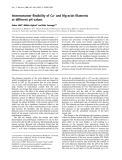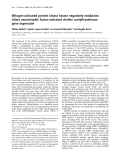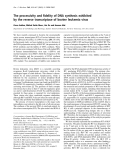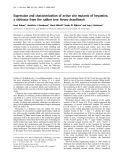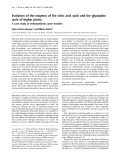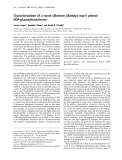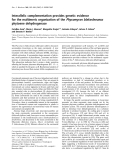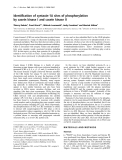§¹i häc Vinh T¹p chÝ khoa häc, tËp XXXVI, sè 1b-2007
CRITICAL DISCOURSE ANALYSIS IN FOREIGN LANGUAGE TEACHING AND LEARNING
(a)
Abstract. Critical Discourse Analysis first emerged in the 1970s as a form of discourse and text analysis that drew attention to not only formal aspects of language in texts but also text production and interpretation, and relation of texts to societal impulses and structures. It has been attracting the attention of many researchers, both linguists and social researchers. In Vietnam, however, Critical Discourse Analysis (CDA) has not yet been known to linguists, researchers, teachers and learners of foreign languages until recently. This article aims at providing an overview of basic issues concerning Critical Discourse Analysis. In this article we will also briefly discuss the relevance of Critical Discourse Analysis in foreign language education.
PHAN HƯƠNG
1. Before as such
disciplines philosophy, psychology and psychiatry, sociology and anthropology, etc. that examine their object of study through language (Cook, 1989: 13).
its name suggests, CDA
is called discourse. It
In
dominance abuse,
2. Critical Discourse Analysis (CDA) is a term used to denote a theory formerly known as Critical Linguistics. is a As discourse analysis approach and it is primarily concerned with studying and analyzing written and spoken texts. So how does CDA differs from other DA approaches? Unlike other approaches to the study of language, CDA focuses on not only linguistic issues but also social, political and historical aspects of texts to reveal the discursive sources of power and inequality. Thus, Critical Discourse Analysis can be simply defined as the analysis of discourse “with an attitude”. NguyÔn Hoµ (2006: 37-38) points out that by taking a stance in favour of those people who are less privileged in the modern life in which the gap between the rich and the poor has become more visible, CDA helps to
addressing Critical Discourse Analysis, let us recall the terms discourse and discourse analysis. Cook (1989) distinguishes between two different kinds of language as potential objects for language study. The first kind is sentence – the object for the study of how the rules of language work. The second kind of language is used “to communicate something and is felt to be coherent” (p. 6). This type of language is agreed upon by many scholars that discourse is language-in-use as opposed to formal aspects of language, and discourse analysis (DA) is the search for how stretches of language become the meaningful and unified. evolution of linguistics, there have been two main approaches to language: the first one is formal approach being concerned with language out of context, taking the rules of language as an isolated object, and the other one is functional approach dealing with language in context (Cook, 1989: 12). Discourse analysis is a branch of the second approach. Discourse analysis is carried out by not only linguists but also by researchers in many other NhËn bµi ngµy 29/9/2006. Söa ch÷a xong 17/11/2006.
53
§¹i häc Vinh T¹p chÝ khoa häc, tËp XXXVI, sè 1b-2007
assumptions,
make changes in social life. CDA sees discourse - language in use in speech and writing - as “a form of social practice” and considers the context of language use to be crucial (Fairclough & Wodak, 1997: 258). CDA starts from the perception of discourse (language and other forms of semiosis) as an element of social practices, which constitutes other elements as well as being shaped by them (Chouliaraki & Fairclough, 1999: vii). It has been agreed by many CDA practitioners that discourse involves power and ideologies. What follows is a brief account of history of CDA, fundamental concepts in CDA, and methodology of CDA.
the of
Wodak (ed.) (1989). These CDA scholars made a great attempt to introduce this new approach the study of into language, explain and illustrate the main principles, procedures and methodology of CDA (Wodak, 2001:5). By the end of the 1980s, CDA was able to describe its aims, research chosen perspective and interests, methods of analysis much more specifically and rigidly that hitherto. The most important characteristics of critical linguistic research are listed, explained and illustrated in Fairclough (1989), Wodak (1989). Later Fairclough (1992, 1995b) and Chouliaraki & Fairclough (1999) explain and elaborate some advances in CDA, showing the development analytical framework for investigating language in relation to power and ideology and also clarifying the usefulness of CDA in disclosing the discursive nature of much contemporary social and cultural change (Wodak, 2001: 6).
“a text analysis
contexts of
introductory interpretation of
2.1 In the 1970s, much linguistic research was merely concerned with the study of formal aspects of language. At that time, researchers argued that these aspects of language constituted speakers’ linguistic competence and they studied them separately from specific instances of language use. Even in pragmatics, where the relation between language and context was taken into account, sentences and components of sentences were still considered to be the basic units. In such a context, Critical Linguistics, or what is known today as Critical Discourse Analysis, emerged as form of that discourse and recognized the role of language in structuring power relations in society” (Wodak, 2001: 5). CDA from its birth not only brought into consideration texts as well as the processes of producing and interpreting texts, it also paid attention to their relations to societal impulses and structures. In the early stage of CDA history, the most prominently and explanatory works are those by Kress & Hodge (1979), Fowler et al. (1979), van Dijk (1985), Fairclough (1989) and 2.2 The concepts of great importance in CDA are critical, historical, power, and ideology (Wodak, 2001: 3-11). For ‘critical’ means “having Wodak, distance to the data, embedding the data in the social, taking a political stance explicitly”. The notion history also occupies a significant position in CDA. According to her, any discourse is “historically produced and interpreted. That means every discourse is “situated in time and space”. There are specific historical reasons that drive people to feel, reason, desire and imagine the way they do. The importance of the discourse historical therefore should be highlighted in the processes and explanation of discourses. ‘Ideology’ in CDA is seen as “an important aspect of establishing and maintaining unequal
54
§¹i häc Vinh T¹p chÝ khoa häc, tËp XXXVI, sè 1b-2007
of the studying then examining
of
one has take to
discourse, investigating the discursive linguistic strategies, means, and the specific, context-dependent linguistic realizations the discriminatory stereotypes (Meyer, 2001: 26-27). Van Dijk focuses on various levels in the analysis of ideologies in news discourse: Social analysis, cognitive analysis and discourse analysis (van Dijk, 1995: 20). Similarly, Fairclough develops a three- for critical dimensional framework analysis of news discourse: text, discourse practice and sociocultural practice (Fairclough, 1995b: 59). text of is, The analysis
power relations”. Language mediates social in a variety ideology institutions. According to Thompson (quoted in Wodak, 2001: 10) the study of ideology is the study of “the ways in is constructed and which meaning conveyed by symbolic forms of various kinds”. For Eagleton (1994), in studying ideology into consideration the variety of theories and theorists that have examined the relation between thought and social reality (quoted in Wodak, 2001: 10). ‘Power’, according to Wodak, is about “relations of difference, … particularly about the effects of differences in social structures”. Surely language itself is not powerful, but gains power by the use powerful people make of it. in
are in
2.3 CDA, according to van Dijk, is not a specific direction of research. Therefore, it does not have a unitary theoretical framework. He asserts that there are many types of CDA (e.g. critical analysis of conversation, of lessons and teaching at school, news reports in the press, etc.), and they can be theoretically and analytically diverse (Meyer, 2001: 17-23).
for Fairclough, “form – and – meaning analysis”, that is, “the analysis of … interwoven meanings texts necessarily comes down to the analysis of the forms of texts”. He argues that “form is part of content” and content cannot be properly analyzed without form simultaneously being analyzed always because “contents forms, and necessarily realized different contents entail different forms and vice versa” (Fairclough, 1995a: 133- 188). Linguistic forms under analysis should include vocabulary, grammar, semantics, the sound system, and cohesion – organization above the sentence level (Fairclough, 1995b: 57). Fairclough also suggests three stages that CDA runs through: description, interpretation and explanation (in NguyÔn Hoµ, 2006: 160). In reality, different discourse analysts adopting different CDA approaches employ various lists of analytical categories. For example, Jager takes into account many linguistic aspects such as certain argumentation strategies, metaphorism, vocabulary and styles, actors, references, etc.; van Dijk concentrates on a great deal of linguistic markers, some among which Methodologies in CDA differ greatly. There can be found in CDA small qualitative case studies as well as studies on large data corpora from ethnography. Each fieldwork and method focuses on different levels of analysis. Siegfried Jager distinguishes two steps of analysis: firstly a more content oriented step of structure analysis, and secondly a more language oriented step of fine analysis within which he focuses upon context, text surface and rhetorical means (Meyer, 2001: 25). Ruth Wodak and Martin Reisigl work out a four-step strategy of analyzing racist and discriminatory the specific discourse: establishing specific contents or topics of a
55
§¹i häc Vinh T¹p chÝ khoa häc, tËp XXXVI, sè 1b-2007
them expand
“different
order to find indicators for particular into concepts and categories, then collect further data. In the analyzing process, new questions may arise, and the answers to these questions can only be found on the basis of analysis of new data or re- examination of earlier data. The linguistic character of CDA becomes evident in the analysis of data since “CDA strongly relies on linguistic categories”.
event:
precisely to Fairclough, of
CDA has opened a new approach to the study of language and also the study of linguistic aspect of social phenomena. With its view of discourse (language in use) as social practice and its methods of analyzing discourse from an interdisciplinary perspective, CDA allows us to have a deeper insight into the relations between language and between society, more language use and language users’ opinions and attitudes behind linguistic features in discourse.
theory linguistic
the begins” and
are: stress and intonation, word order, lexical style, topic choice, schematic organization, etc (Meyer, 2001: 25). The analysis of discourse practice involves sociocognitive aspects of text production consumption. For Fairclough and (1995a: 134), sociocultural practice may involve levels of social organization” such as “the context of situation”, “the institutional context”, and “the wider societal context” or “context of culture”. Fairclough (1995b: 62) outlines more specifically three aspects of the sociocultural context of a communicative economic, political and cultural. According to him, when considering a communicative event, the analyst should take into consideration not necessarily all levels but any level that might be relevant to understanding that particular event. critical According discourse any analysis communicative event is the analysis of relationships between the three above- mentioned dimensions of that event. Discourse practice plays the mediating role between text and sociocultural practice. The relationship between the sociocultural and textual facets is an indirect one and made by way of discourse practice. That is, properties of sociocultural practice shape texts, but indirectly through shaping the nature of discourse practice, which is realized in features of texts. Regarding collecting data, Meyer (2001: 23-25) maintains that in CDA there is no typical way, and that no clear-cut boundary between data collection and data analysis can be made. Data collection is not regarded as “a specific phase that must be completed before analysis “is never completely excluded. It can be spelt out that researchers may begin to analyze data right after the first collection in 3. Another important issue that needs to be addressed is the theory upon which Fairclough (1995a, 1999, 2003) and many other researchers draw for their analytical framework. This is Systemic Functional Linguistics (SFL), a particularly associated with Michael Halliday. According to Halliday, this theory of language can help researchers to make transparent the relationship between the grammatical system and the social and personal needs that language is required to serve. In discussing the role of SFL in CDA, Fairclough (2003) points out that SFL is a valuable source for critical discourse analysis since it is concerned with relationship between language and other elements and aspects of social life. It has been the foundation for Fairclough’s analytical framework of
56
§¹i häc Vinh T¹p chÝ khoa häc, tËp XXXVI, sè 1b-2007
of the intersection
in the world),
more, since discourses are ideological and there is no arbitrariness of signs, SFL can therefore be considered to be the most important for the text analysis in order to uncover the ideological meanings hidden within texts. To cut it short, all the above- mentioned information provides proofs for the claims made by Fairclough & Chouliaraki (1999: 139) that SFL “has most in common with CDA and most to offer CDA”, and that it “theorizes language in a way which harmonizes far more with the perspective of critical social science than other theories of language”.
‘networks’ three major
and learning
and learning
reading that
“need a
‘ideational’, CDA since there is a “complementary relationship” between SFL and CDA. Fairclough & Chouliaraki (1999: 140) state that in SFL lexicogrammar is “functionally grounded, shaped by the social functions it serves, and … built around the ‘macrofunctions’ of language”. The ‘macrofunctions’ of language include the ideational function (language in the construction and representation of experience the interpersonal function (language in the enactment of social relations and the construction of social identities), and the textual function (language in the specifically semiotic – textual – form of productive practice). Corresponding to these three macrofunctions of language are of grammatical system (transitivity, mood and modality, and information). In the light of SFL text is not static but is seen as always located in and participating in the social process, and language is seen dialectically as ‘structured’ and ‘structuring’. The relationship between the semiotic and the social in SFL is viewed as a dialectical one in the sense that language “internalize differences in social membership and relations”, and the social itself “is constructed as internalizing language” (p. 142). Since CDA’s subject of study is discourse – language in use, which is “always simultaneously constitutive of (i) social identities, (ii) social relations and (iii) system of knowledge and beliefs” (Chouliaraki & Fairclough, 1999: 131), here is where SFL can make contributions to CDA. They claim that theory of CDA analysts language such as Halliday’s, which stresses its multifunctionality and sees any text as simultaneously enacting … ‘interpersonal’, and the ‘textual’ functions of language”. What is 4. Let us now proceed to a brief discussion of the relevance of Critical Discourse Analysis in foreign language teaching and learning. Why Critical Discourse Analysis can contribute to foreign teaching languages? We will limit ourselves to teaching reading comprehension as a foreign language skill in universities. Here come some important questions. The first question that needs to be taken into account is how important discourses and texts are in education. For van Dijk (van Dijk, 1981), “discourses play a primary role in education” as “most of our learning materials consists of texts”, and the various uses of texts ‘influence the process of learning: the acquisition of knowledge, beliefs, opinions, attitudes, abilities, and other cognitive and emotional changes’ (p. 2). Van Dijk also asserts and comprehension of the various discourse materials is ‘one of the most serious textual problems’ (p. 21). In the case of foreign language learning, the learner reads texts not only to study the target language but also to learn from text and to learn about the world. Reading
57
§¹i häc Vinh T¹p chÝ khoa häc, tËp XXXVI, sè 1b-2007
language learning
especially task, materials in a target language for and effective profound understanding is, therefore, a challenging those written by foreigners.
if necessary reject
critical
conveying not in but The question that follows is why it is a challenging task. Fairclough (1995b: 106-107) observes that any text is a combination of explicit and implicit meanings. He asserts that the reader of that text should focus not just on what is ‘there’ in the text. In other word, it is of equal importance to be sensitive to both ‘presences’ (what is ‘there’ in the text) and ‘absences’ (what might have been ‘there’, but aren’t). To achieve this, readers should develop the skill of reading between the lines, or ‘critical reading’, the term used by Wallace (1992: 59), that is, readers need to audiences. become more Wallace claims that one of the goals of critical reading is reconstructing the discourses within the text and ‘Central to the idea of critical reading is an awareness of the role that language just a plays propositional message an ideological one’ (p. 68-69).
and learning
content as well as propositional meaning of the reading texts. Last but not least, teachers and students should not always accept automatically the writer’s view of the world which impose on the language tends to readers. Rather, they need to question and the pre- established view of the world presented in reading texts. In short, since discourses and texts are vital in education in general and foreign language teaching and learning in particular, how to use texts is significant. For an effective use of texts learning reading in teaching and teachers and comprehension, both learners need to develop the skill of critical reading. CDA is an approach to language study that can make its practical contributions to the field of foreign language education in the sense that it drives teachers and learners to be aware of social and historical aspects of texts as well as the role of both text producers and text interpreters when dealing with them. To make clear the role of CDA in foreign language teaching and learning, let us now consider an example of how CDA can be useful in teaching and learning reading comprehension. The text chosen as a possible reading material for students of English is a news report on Iraq in a British newspaper, The Guardian. The title of the news report is “UN team finds Iraq has illegal missiles”. This text is authentic in the sense that it is not written for pedagogic purpose. The general aims of the reading tasks are to encourage reflective critical reading of the text and to help raise awareness of the ideology of the text. Then, what can be done to train students to become critical readers, not just for the purpose of their foreign language learning in schools but for the sake of their life-long reading? What follow are some implications of CDA to reading teaching comprehension. First, reading activity should always be placed in social and historical context. Second, students should be encouraged to look critically at texts themselves and at the whole process of reading as dependent on social context. Third, there is a constant need for teachers to guide students (readers) to an awareness of ideological
58
§¹i häc Vinh T¹p chÝ khoa häc, tËp XXXVI, sè 1b-2007
Typical Ones
- What is your personal opinion about the topic?
Pre- reading tasks
While- reading tasks
Post- reading tasks
- Ask all students to read the whole text and find the answers to given questions - Match the words in column A with their definitions in column B - Say whether the following statements are true or false - Find a word/phrase in the text to complete the summary paragraph - Write a summary of the text - Do you think Iraq has illegal missiles?
Possible Critical Ones - What is the topic? (ask the students to scan the headline, subheading) - What does the title tell you? - Why has the topic been selected? - Ask each group to read a paragraph and write 5 questions, then exchange the paragraphs and answer questions about a different paragraph generated by another group - Find presupposition-embedded clauses. What presuppositions are they? Why are they embedded in the text? - How does the writer construct the image of Iraq as possessing illegal missiles? (lexical repetition) - What is the image of the UN team? What strategies does the writer use to achieve this? (lexicalization, voice usage, etc.) - How does the writer build up the US and Britain’s determination to take action on Iraq? - Who is writing to whom? - What message does the writer want to pass on to the readers? - Do you think it is a true message? Why/why not? - In what other ways could the text have been written? (less hostile toward Iraq)
perspective does not simply require an understanding of what is present in the text but also an interpretation of what is hidden from the text. language. A
The above suggested questions help clarify how CDA can be applied into learning English as teaching and foreign reading comprehension activity from the critical
Conclusion
precisely
from an
society, more between language use and power and ideology brought into discourse by language users, is that CDA sees discourse (language in use) as social practice and that CDA attempts at analyzing discourse interdisciplinary perspective. Beside its significance in linguistic and social researches, CDA also plays an active role in language teaching and learning. The knowledge of CDA will help raise the awareness of the importance of (i) processes of text (ii) production and interpretation, With the emergence of critical discourse analysis, there has been a new approach to the study of language that takes into consideration not only formal aspects of language in texts but also the role of text producers and interpreters, and the relation between texts and social aspects as well. In other words, CDA provides a theoretical framework and an effective tool for the study of language in use and linguistic aspect of social phenomena. What can help us achieve a deeper insight into the relations between language and
59
§¹i häc Vinh T¹p chÝ khoa häc, tËp XXXVI, sè 1b-2007
discursive practices used in texts, and (iii) what is present in texts as well as what is absent from texts. It can help people become conscious of “how language can be ... disrespectful, offensive, excusive, or the opposite” (Janks, H. & Ivanic, R., 1992: 312). This critical view of discourses and texts will bring about a better understanding and use of texts in teaching and learning foreign languages, particularly reading comprehension.
References [1] Chouliaraki, L. & Fairclough, N. (1999) Discourse in Late Modernity: Rethinking
Critical Discourse Analysis. Edinburgh: Edinburgh University Press.
[2] Cook, G. (1989) Discourse. Oxford: Oxford University Press. [3] Fairclough, N.L. (1995a) Critical Discourse Analysis: The critical study of language. London: Longman.
[4] Fairclough, N.L. (1995b) Media discourse. London: Edward Arnold. [5] Fairclough, N.L. & Wodak, R. (1997) ‘Critical Discourse Analysis’, in T.A. van Dijk (ed.), Discourse Studies: A Multidisciplinary Introduction, Vol.2. London: Sage, pp. 258-284.
[6] Meyer, M. (2001) ‘Between Theory, Method, and Politics: Positioning of the Approaches to CDA’, in Ruth Wodak and Michael Meyer (eds.), Methods of Critical Discourse Analysis. London: Sage Publications, pp. 15-31. [7] NguyÔn Hoµ (2006) Ph©n TÝch DiÔn Ng«n Phª Ph¸n: Lý LuËn vµ Ph−¬ng Ph¸p. Hµ Néi: Nhµ xuÊt b¶n §¹i häc Quèc gia. [8] van Dijk, T.A. (1981) ‘Discourse Studies and Education’, Applied Linguistics, 2, pp. 1-26.
[9] Wallace, C. (1992) ‘Critical literacy awareness in the EFL classroom’, in N.L. Fairclough (ed.), Critical Language Awareness. London & New York: Longman, pp. 59-62.
[10] Wodak, R. (2001) ‘What CDA is about – a Summary of Its History, important Concepts and its Development’, in R. Wodak and M. Meyer (eds.), Methods of Critical Discourse Analysis. London: Sage Publications, pp. 1-13.
TãM T¾T
PHÂN TÍCH DIÔN NG«N PHª PH¸N TRONG D¹Y VÀ HäC Ngo¹I NG÷
Ph©n tÝch diÔn ng«n phª ph¸n (CDA) kÓ tõ khi b¾t ®Çu xuÊt hiÖn vµo nh÷ng n¨m 70 cña thÕ kû tr−íc ®· thu hót sù quan t©m cña c¸c häc gi¶ kÓ c¶ c¸c nhµ ng«n ng÷ häc vµ x· héi häc. §−êng h−íng ph©n tÝch diÔn ng«n nµy kh«ng chØ ph©n tÝch c¸c khÝa c¹nh cÊu tróc ng«n ng÷ trong v¨n b¶n mµ cßn quan t©m tíi c¸c qu¸ tr×nh t¹o lËp vµ diÔn gi¶i v¨n b¶n, ®ång thêi xem xÐt mèi quan hÖ gi÷a v¨n b¶n vµ c¸c xung ®ét còng nh− cÊu tróc x· héi. ë ViÖt Nam ph−¬ng ph¸p ph©n tÝch diÔn ng«n nµy ch−a ®−îc nhiÒu ng−êi biÕt ®Õn. Môc tiªu cña bµi viÕt nµy nh»m cung cÊp cho ®éc gi¶ mét c¸i nh×n toµn c¶nh c¸c vÊn ®Ò c¬ b¶n liªn quan tíi CDA ®ång thêi b−íc ®Çu bµn luËn vÒ vai trß cña ph©n tÝch diÔn ng«n phª ph¸n trong viÖc d¹y vµ häc ngo¹i ng÷. (a) Department of Foreign Languages, Vinh University












